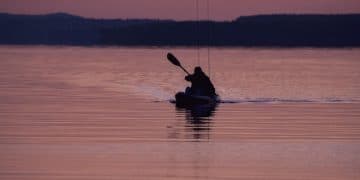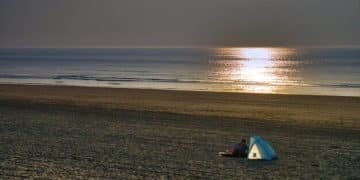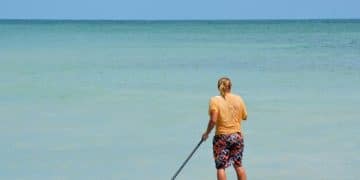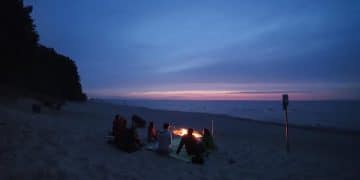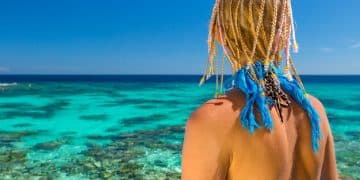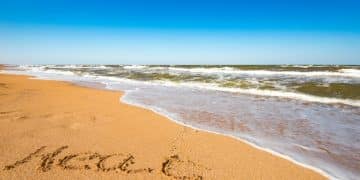Beach Fishing for Beginners: Gear, Techniques & Success Tips
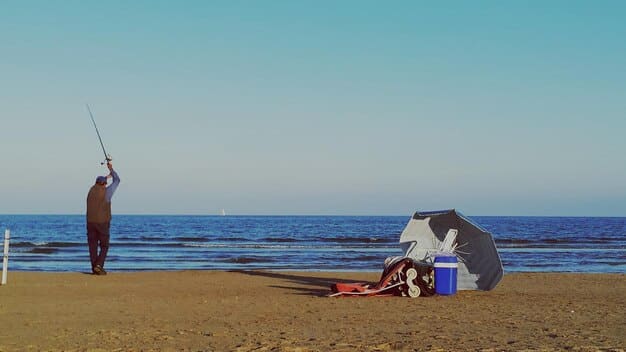
Beach fishing for beginners involves understanding essential gear like rods, reels, and bait, mastering casting techniques, and learning about tides and local regulations to ensure a successful and enjoyable experience.
Embarking on the adventure of beach fishing for beginners: essential gear and techniques for a successful catch can seem daunting, but with the right knowledge, you can turn a day at the beach into a rewarding angling experience. This guide will walk you through everything you need to know to get started, from selecting the appropriate gear to mastering basic casting techniques.
Getting Started with Beach Fishing
Beach fishing offers a unique and accessible way to enjoy the sport of angling. Unlike boat fishing or fishing from piers, beach fishing allows you to get close to the water and experience the tranquility of the ocean. For beginners, understanding the basics is crucial before heading out.
First thing’s first, before even getting ready to start fishing, you need to make sure you have a fishing license. Fishing license requirements vary in different states. More information can be found on your specific state’s website.
Understanding the Surf Zone
The surf zone is where the waves break, creating an area rich in marine life. Fish often congregate here to feed, making it a prime location for beach fishing.
Reading the Beach
Learn to identify features like sandbars, troughs, and channels. These areas often hold fish, and knowing where to cast can significantly increase your chances of a catch.
- Sandbars: Elevated areas of sand that can attract fish seeking shelter.
- Troughs: Depressions between the sandbar and the shoreline, where fish often travel.
- Channels: Deeper pathways that fish use to move in and out with the tide.
Understanding the surf zone and how to read the beach can greatly improve your initial beach fishing attempts. Take the time to observe the water and learn the local fishing spots to enhance your chances of success.
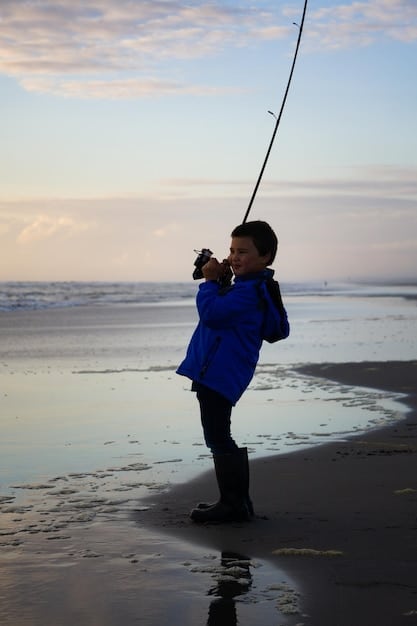
Essential Gear for Beach Fishing
Having the right equipment is essential for a successful beach fishing trip. The gear you need will depend on the type of fish you’re targeting and the conditions of the beach.
Here’s a breakdown of the essential gear:
Rod and Reel
A medium to heavy-duty rod, around 9 to 12 feet long, is ideal for beach fishing. Pair it with a saltwater-resistant spinning or baitcasting reel.
Line and Leader
Use a durable monofilament or braided line with a test strength of 15 to 20 pounds. Add a fluorocarbon leader for increased stealth.
- Rod: Consider a 9-12 foot rod for better casting distance.
- Reel: Opt for a saltwater-resistant spinning reel in the 4000-6000 size range.
- Line: Use 15-20 pound test monofilament or braided line.
Hooks, Sinkers, and Swivels
Choose hooks appropriate for the size of fish you’re targeting. Use a variety of sinkers to keep your bait on the bottom and swivels to prevent line twist.
Bait and Lures
Live bait such as sand fleas, shrimp, and bloodworms are highly effective. Artificial lures like spoons, jigs, and soft plastics can also be used.
Selecting the correct gear will set you up for a successful day of fishing.
Mastering Basic Casting Techniques
Casting is a fundamental skill in beach fishing. The goal is to cast far enough to reach the fish while also maintaining accuracy. Here are some techniques for beach fishing success:
Practicing your casting technique will help you get your line where it has the best chance of attracting fish!
The Overhead Cast
This is a common and effective casting technique. Stand with your feet shoulder-width apart, hold the rod behind you, and swing it forward in a smooth motion, releasing the line as the rod reaches its apex.
The Side Cast
The side cast is useful when there is wind or when you need to cast under obstructions. Keep the rod parallel to the ground and swing it to the side, releasing the line at the desired point.
- Overhead Cast: A reliable technique for distance.
- Side Cast: Ideal for windy conditions or casting under obstacles.
- Practice: Refine your technique in an open area before hitting the beach.
Tips for Longer Casts
Use a longer rod, heavier sinker, and streamlined bait or lure for increased distance. Practice timing your release point for maximum casting power.
With practice, you’ll be able to accurately cast to where the fish are biting!
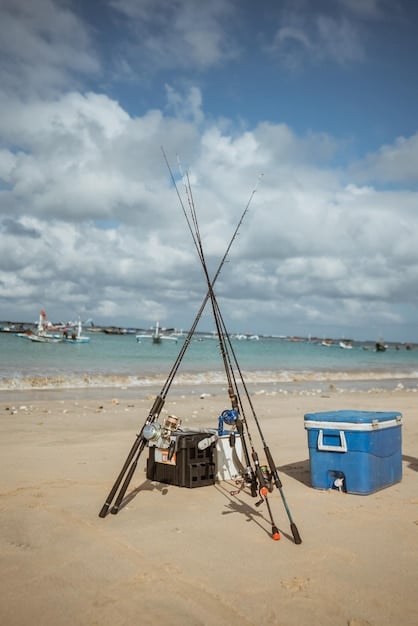
Understanding Tides and Weather
Tides and weather conditions play a significant role in beach fishing. Knowing how these factors affect fish behavior can improve your chances of success.
Understanding the effect tides and weather conditions have on fish behavior, will help you have more success at landing a fish!
Tidal Patterns
Fish activity often increases during high tide and the hours surrounding it. Incoming tides bring fresh bait and nutrients, attracting fish closer to shore.
Weather Conditions
Overcast days can be better for fishing than bright, sunny days. Wind can also impact fishing, with light to moderate winds often stirring up the water and attracting fish.
- High Tide: Often coincides with increased fish activity.
- Overcast Days: Can provide better fishing conditions than bright sunlight.
- Wind: Light to moderate winds can stir up the water and attract fish.
Using Tide Charts
Consult tide charts and weather forecasts before your fishing trip. Plan your trip around the high tide and be prepared for changing weather conditions.
Knowledge of tides and weather is essential for optimizing your time on the beach when fishing.
Choosing the Right Bait and Lures
Selecting the right bait and lures is another key component of success in beach fishing. Different fish species are attracted to different types of bait, so it’s important to match your offering to your target species.
Matching your offering to your target species is a great way to entice fish to your line!
Live Bait Options
Sand fleas, shrimp, and bloodworms are popular choices for live bait. These natural baits are highly attractive to a variety of fish species.
Artificial Lures
Spoons, jigs, and soft plastics can be effective artificial lures. These lures mimic the movement of baitfish and can trigger strikes from predatory fish.
- Sand Fleas: Effective for targeting species like pompano and whiting.
- Shrimp: A versatile bait that attracts a wide range of fish.
- Spoons: Mimic the flash and movement of baitfish, attracting predatory species.
Tips for Bait Presentation
Use a sharp hook and present your bait in a natural way. For lures, vary your retrieval speed and action to find what works best for the conditions.
Choosing the right bait or lure for the fish you are trying to catch and the fishing conditions is an important skill that will help you catch more fish.
Beach Fishing Safety and Regulations
Safety should always be a top priority when beach fishing. Be aware of potential hazards and follow all local fishing regulations to ensure a safe and responsible fishing experience. It is also important to follow basic first aid protocol in the event of injury.
Safety should always be your first priority!
Beach Hazards
Be mindful of strong currents, waves, and marine life. Wear appropriate clothing and footwear to protect yourself from the elements.
Fishing Regulations
Check local fishing regulations for size and bag limits, restricted areas, and licensing requirements. Obtain the necessary permits before fishing.
- Currents and Waves: Be aware of potential hazards and avoid fishing in dangerous conditions.
- Marine Life: Watch out for jellyfish, stingrays, and other marine creatures.
- Licensing: Ensure you have the necessary fishing license and follow all regulations.
Environmental Responsibility
Dispose of trash properly and avoid leaving fishing line or other debris on the beach. Practice catch and release to help conserve fish populations.
Fishing responsibly will help you to be safe, protect the environment, and conserve fish for future fishing adventures!
| Key Point | Brief Description |
|---|---|
| 🎣 Essential Gear | Having the right rod, reel, and tackle is key for beach fishing. |
| 🌊 Understanding Tides | Fish activity often increases during high tide. |
| 🌦️ Weather Impact | Overcast days can be better for fishing than sunny days. |
| 📜 Local Regulations | Check local fishing regulations for size and bag limits. |
Frequently Asked Questions
▼
The best time for beach fishing is typically during the early morning or late afternoon when the sun isn’t as intense, and fish are more active. High tide is another good time.
▼
Popular bait choices include sand fleas, shrimp, and squid. Artificial lures like spoons and jigs can also be effective when targeting predatory fish.
▼
Look for features like sandbars, troughs, and channels. Fish often congregate near these areas, so casting near them can increase your chances of success.
▼
Be mindful of currents, waves, and marine life. Wear appropriate clothing and footwear. Always check the weather forecast and let someone know your fishing plans.
▼
Yes, a fishing license is typically required for beach fishing. Check local fishing regulations for licensing requirements in your area before heading out fishing.
Conclusion
Beach fishing can be an incredibly rewarding experience for beginners. By understanding the essential gear, mastering basic techniques, and prioritizing safety, you can significantly increase your chances of a successful catch. So grab your rod, head to the beach, and start your angling adventure!
